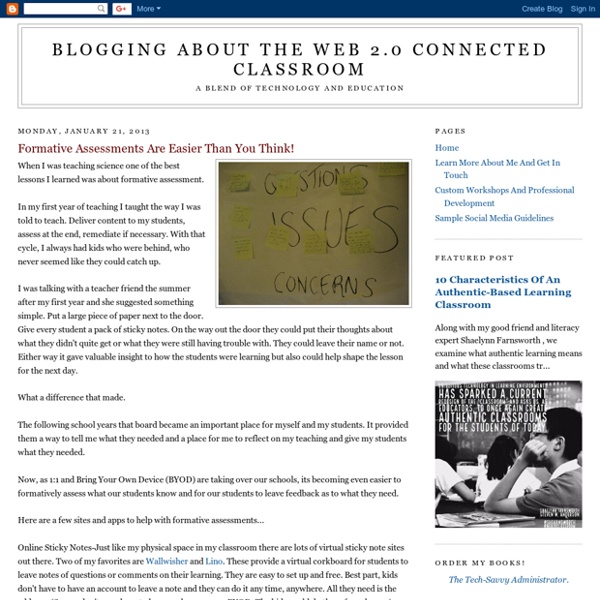Cybraryman Internet Catalogue
My Goal Mavens @coolcatteacher@angelamaiers@wmchamberlain Each year I had my students write their learning goals or resolutions for the year on the first day of school. I had them review and update them periodically throughout the school year.
The Ultimate List – 65 Digital Tools and Apps to Support Formative Instructional Practice
There is no shortage of strategies, techniques, and tools available to teachers (and students) who use formative instructional practice in their classrooms. We’ve compiled an extensive list of 65 digital tools, apps, and platforms that can help teachers use formative assessment to elicit evidence of student learning. These tools and apps for formative assessment success give teachers (and students) many options and opportunities for classroom success. To get the most out of formative instructional strategies, check out our NWEA® formative practices workshops.
The Five Best Tools for Creating Videos Without Installing Software
Over the years I've published some lists and reviews of free tools for creating videos online. Quite a few of those tools have been for creating simple videos that are really just automated, audio slideshows. See Animoto for an example of this. There's nothing inherently wrong with having your students use those tools, but at some point you will want to take your video projects to the next level. These are the five tools that I recommend for creating and editing videos without installing any special software.
Reflecting on and refining assessment tasks
It’s important educators understand where students are in their learning, and there are lots of ways to monitor this progress that can inform meaningful feedback and next steps. One example is an end of semester or end of unit assignment or portfolio task developed by the subject or classroom teacher. If you’ve designed one of these tasks, think about the process you undertook. Did the task hit the mark, in terms of quality and differentiation? At Canberra College, in the Australian Capital Territory (ACT), staff use an evidence-informed framework to reflect on and improve the quality of their set assessment tasks. Deputy Principal Peter Clayden says it was introduced following a simple request to executive staff from a 'grassroots level' of teachers: ‘Help us make our tasks better’.
Assessment
Section 4: Measuring for Learning Goal: At all levels, our education system will leverage the power of technology to measure what matters and use assessment data to improve learning. Measuring learning is a necessary part of every teacher’s work.
teachnology / Digital Storytelling
DigiTales- The site created by Bernajean Porter, with resources for digital storytelling, many of which are linked below Center for Digital Storytelling- Based in Berkeley, with international digital storytelling resources Digital Storytelling Cookbook- By Joe Lambert, from the Center for Digital Storytelling The Educational Uses of Digital Storytelling- Site from University of Houston, with examples, guidelines, tips, and other resources, many of which are linked below The DAOW of Storytelling- by Jason Ohler, another look at the elements of digital storytelling; a good lunchtime read!
10 ways to encourage student reflection…
Split Screen Teaching Optimal learning occurs when students are active participants in their own learning, rather than passive recipients of teacher-delivered content. For this to be effective, students really need to think about their learning. I worked with a group of teachers recently who felt their young students were not capable of writing meaningful reflections for their end of semester reports. That might be true. But only if reflection and meta-cognition are not integral parts of the learning in their classes.
Why Curation Will Transform Education and Learning: 10 Key Reasons
There is a growing number of key trends that are both rapidly revolutionizing the world of education as we know it and opening up opportunities to review and upgrade the role and scope of many of its existing institutions, (as the likeliness that they are going to soon become obsolete and unsustainable, is right in front of anyone's eyes). George Siemens, in his recent Open Letter to Canadian Universities, sums them up well: 1) An Overwhelming Abundance of Information Which Begs To Be OrganizedThe goal is not (and probably it never was) to learn or memorize all of the information available out there. It's just too much even if we focus only on the very essence of it. The goal is to learn how to learn, to know where to look for something and to be able to identify which parts of all the information available are most relevant to learn or achieve a certain goal or objective.This is why new digital literacy skills are of such great importance.
edutopia
Formative assessment is an important part of effective instruction. Teachers can use observations, checklists, and quick quizzes to gather data that will inform their instruction. Formative assessment identifies areas where students are excelling and struggling so that teachers can best alter their instruction to meet the needs of all students.
How Can Web 2.0 Curation Tools Be Used in the Classroom?
Digital Tools Jeff Thomas “Curation” may be one of the big buzzwords of 2011. As the amount of information accumulates thanks to the Web, it becomes increasingly important that we use tools to help us find information that’s relevant and useful.



